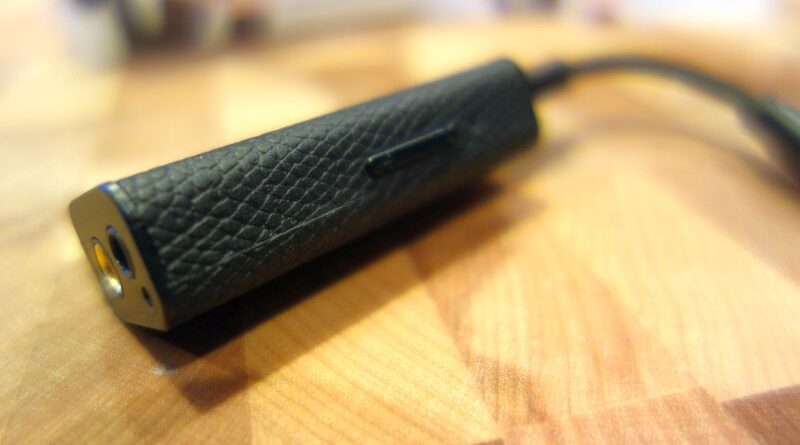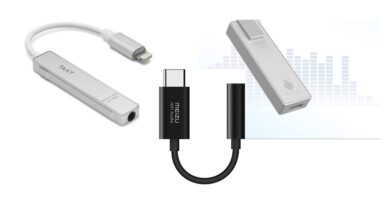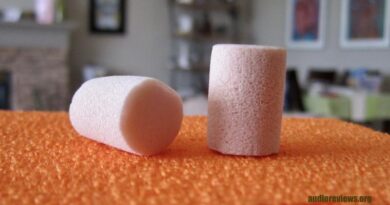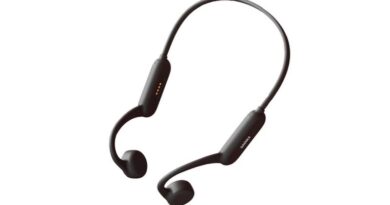Truthear SHIO DAC Review (1) – Transparent Tingles
In this Article
INTRO
The Truthear SHIO DAC jumps into the deep end and joins the pool of dingle dangle dongles. The design sports a CS43198 dual DAC which is less used for dongles, the finish and size moves away from other competitors aiming to distinguish itself as something different. I find the Truthear SHIO even keeled and controlled, with low power consumption and you get both 3.5mm and 4.4mm outputs and excellent transparency priced at $69.
Disclaimer: Shenzenaudio provided this for entertainment and intrigue free of charge and without government control.
PACKAGE CONTENTS
I do not normally comment on box packaging unless there was something interesting like The Truthear SHIO box rear printing was upside down. Same thing happened on the Truthear Halo, but not sure if this is by design or accident.
Inside is a dongle wrapped in a cracked leather like texture, unfortunately they missed the opportunity to wrap cleanly with the seam appearing next to the buttons. It is clearly glued on and would have looked more luxurious with some other way to hide this seam. If it peels off down the road, chances are a new shiny dongle will grab our attention.
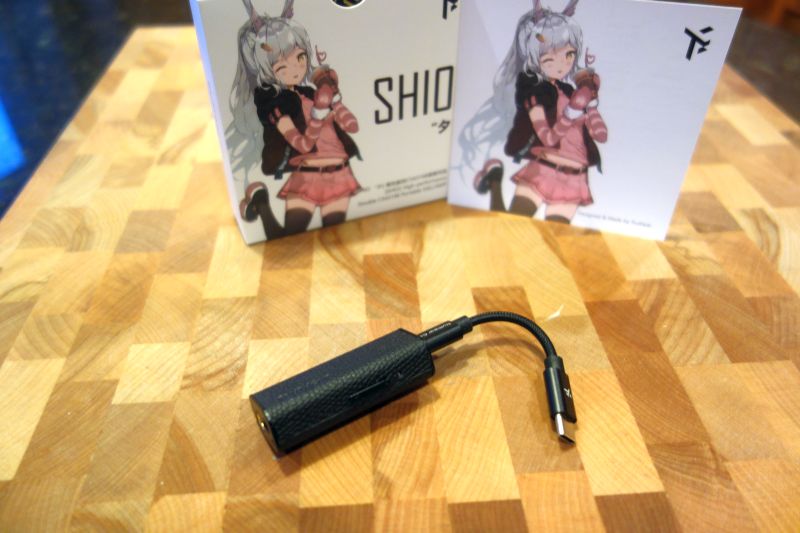
The short USB-C to USB-C cable was mated with the winking Waifu collector card named Shiro. Missing was a USB-C to USB-A adapter for use in a computer that is not equipped with the latest port connections. A USB-C to Lightning cable is sold separately.
Speaking of ports, the power light glows through 3.5mm headphone jack tricking you that its an optical interface as well. Unintended, it helps you locate the jack in the dark. The 4.4mm balanced output provides a welcoming robust connection over the smaller sibling 2.5mm balanced giving us an improvement to channel separation.
CONTROLS
There is a thin volume toggle button located on the side of the Truthear SHIO. It serves a dual function, changing volume when one side of it is pushed, or if you push both volume UP/DOWN at the same time it will toggle high and low gain modes. High gain is enough to blow your ear drums out with sensitive IEMs with its 150mW at 32ohms.
I recommend to use the low gain setting unless driving higher impedance headphones, my experience is 150ohm or less. The Sennheiser HD6XX are under-powered at this level, but the Philips X2HR Fidelio are right at home.
Note when using the Hiby app, make sure to change the volume output setting to utilize “hardware” volume. Software volume mode will decrease output and not give you full capabilities. I realized later my experience with the HIDIZS XO the same thing occurred.
There are no other track/up down controls so that is missing, and no chance to use an earphone with TRRS controls either. More on that later.
GUTS
The Truthear SHIO does not use the more popular CS43131, or any of the ES9219C or ES9038Q2M SoC chips or even the AKM4493 that appears to have come back online. I am curious as to why they chose the CS43198. The CS43131 has a power consumption between 2.6-40mW, the CS43198 is fixed at 26mW, so normally a designer might choose the CS43131 for battery connections and CS43198 for fixed powered installations.
Looking closer at the datasheet, there is minimal difference, it’s as if the marketing department chose to highlight certain features of each chip, but on paper they appear similar. If I am to believe the sheet and diagram, the 43131 is better for dongles as it has feedback of the headphone detection system to monitor DC and AC signals and to accommodate an input (microphone).
The CS43198 only has detection of the presence of headphones with no mention of an analog input channel. So what does this mean for regular users…the 3.5mm singled ended output does not support microphone input via TRRS on the Truthear SHIO. Just a design choice, there really is no other improvement over the CS43131.
Tested with Moondrop Dawn, Oppo PM-3.
SOUND
The Truthear SHIO sounds precise and controlled curt bass hits with a quick decay profile. It is very neutral and sounds so close to my usual affair I can only assume that my DAP is the device coloring the sound. Noise-free and excellent, there is not much to report in terms of a signature sound profile it exudes.
Compared to the HDIZS XO also equipped with dual DACs and single/balanced outs, the Truthear SHIO delivers to the best I can describe- analog bass, the HDIZS XO sounds like it aims for a staccato finish to bass notes not letting them develop fully.
Although it is extremely hard to pick this out, it is one of the only differences to my ears. This quickness might give the impression of a cleaner resolution, or we can classify them as analog vs digital is a typical comparison. I find them both equally competent, but the Truthear SHIO is cheaper and consumes less power.
FINAL REMARKS
The Truthear SHIO is another completely transparent DAC dongle that goes beyond the music source specifications and allows it to rise near the tops of SINAD chart gods. It does not support TRRS but does support 3.5mm and 4.4mm with a switchable gain and low power consumption. If these are the requirements you seek, it is an excellent device.
It also costs the same as the Moondrop Dawn series that is equivalent except it lacks both output ports and has a non-removable cable. The Truthears SHIO would be the one to get instead in terms of value. My only nitpick is the seam on the leather wrap (see title photo), and no track controls.
If it does not meet your requirements then there plenty of choices out there. That is the DAC dongle world…full of choices and differing features at given price points.
SPECIFICATIONS TRUTHEAR SHIO
- DAC Chip:CS43198 *2pcs
- Sampling Rate (Maximum):PCM 44.1kHz – 768kHz | DSD64 – DSD256
- Interface Type: USB-C input
- 3.5mm single-ended output
- 4.4mm balanced output
- THD+N (@1kHz) (A-WT):
- 3.5mm SE: <0.00025%
- 4.4mm BAL: <0.0002%
- Output:
- 3.5mm SE: 1.4Vrms(Low Gain), 2Vrms (High Gain)
- 4.4mm BAL: 2Vrms(Low Gain), 4Vrms (High Gain)
- Output Power:
- 150mW x2 @32Ω
- 55mW x2 @300Ω
- SNR: 130dB (A-WT)
- Dynamic Range: 130dB (A-WT)
- SINAD: 117dB
- Frequency Response: 20-20kHz (±0.1dB)
- Background Noise: <1.6uVrms (A-WT)
DISCLAIMER
Get it from SHENZENAUDIO.
Our generic standard disclaimer.



